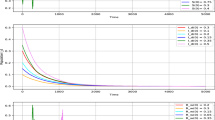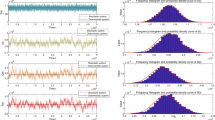Abstract
In this paper, we study a susceptible-infectious-recovered model with a nonlinear incidence rate. Assume that the infected individual has large immunity failure rate, then it becomes a slow–fast system. Using geometry singular perturbation theory, we revealed that it exhibits rich dynamics, such as supercritical Hopf bifurcation, canard explosion and relaxation oscillation.





Similar content being viewed by others
References
Capasso, V., Serio, G.: A generalization of the Kermack-McKendrick deterministic epidemic model. Math. Biosci. 42, 43–61 (1978)
De Maesschalck, P., Dumortier, F., Roussarie, R.: Canard cycle transition at a slow–fast passage through a jump point. CR. Math. Acad. Sci. Paris. 352, 317–320 (2014)
Hu, Z., Bi, P., Ma, W., Ruan, S.: Bifurcations of an SIRS epidemic model with nonlinear incidence rate. Discrete Contin. Dyn. Syst. Ser. B. 15(1), 93 (2011)
Kermack, W.O., McKendrick, A.G.: A contribution to the mathematical theory of epidemics. Proc. R. Soc. Lond. Ser. A. 115, 700–721 (1927)
Krupa, M., Szmolyan, P.: Extending geometric singular perturbation theory to nonhyperbolic points—fold and canard points in two dimensions. SIAM. J. Math. Anal. 33, 286–314 (2001)
Krupa, M., Szmolyan, P.: Relaxation oscillation and canard explosion. J. Differ. Equ. 174, 312–368 (2001)
Li, C., Li, J., Ma, Z., Zhu, H.: Canard phenomenon for an SIS epidemic model with nonlinear incidence. J. Math. Anal. Appl. 420, 987–1004 (2014)
Li, C., Lu, K.: Slow divergence integral and its application to classical Linard equations of degree 5. J. Differ. Equ. 257, 4437–4469 (2014)
Li, J., Zhou, Y., Wu, J., Ma, Z.: Complex dynamics of a simple epidemic model with a nonlinear incidence. Discrete Contin. Dyn. Syst. Ser. B. 8, 161 (2007)
Li, S., Wang, C., Wu, K.: Relaxation oscillations of a slow–fast predator–prey model with a piecewise smooth functional response. Appl. Math. Lett. 113, 106852 (2021)
Liu, W., Hethcote, H.W., Levin, S.A.: Dynamical behavior of epidemiological models with nonlinear incidence rates. J. Math. Biol. 25, 359–380 (1987)
Liu, W., Levin, S.A., Iwasa, Y.: Influence of nonlinear incidence rates upon the behavior of SIRS epidemiological models. J. Math. Biol. 23, 187–204 (1986)
Ruan, S., Wang, W.: Dynamical behavior of an epidemic model with a nonlinear incidence rate. J. Differ. Equ. 188, 135–163 (2003)
van den Driessche, P., Watmough, J.: A simple SIS epidemic model with a backward bifurcation. J. Math. Biol. 40, 525–540 (2000)
Wang, C., Zhang, X.: Relaxation oscillations in a slow–fast modified Leslie–Gower model. Appl. Math. Lett. 87, 147–153 (2019)
Xiao, D., Ruan, S.: Global analysis of an epidemic model with nonmonotone incidence rate. Math. Biosci. 208, 419–429 (2007)
Xiao, D., Zhou, Y.: Qualitative analysis of an epidemic model. Can. Appl. Math. Q. 14, 469–492 (2006)
Zhang, Y., Zhou, Y., Tang, B.: Canard phenomenon in an SIRS epidemic model with nonlinear incidence rate. Int. J. Bifurc. Chaos. Appl. Sci Engry. Internat. 30, 2050073 (2020)
Zhou, Y., Xiao, D., Li, Y.: Bifurcations of an epidemic model with non-monotonic incidence rate of saturated mass action. Chaos Soitions Fractals 32(5), 1903–1915 (2007)
Acknowledgements
We thank the reviews for their valuable comments and suggestions that helped us to improve the presentation of our paper. This work supported by NNSF of China (No. 12071091) and the Natural Science Foundation of Guangdong Province, P.R. China (No. 2019A1515011885).
Author information
Authors and Affiliations
Corresponding author
Ethics declarations
Conflict of interest
The authors declare that they have no conflict of interest.
Additional information
Publisher's Note
Springer Nature remains neutral with regard to jurisdictional claims in published maps and institutional affiliations.
Rights and permissions
Springer Nature or its licensor holds exclusive rights to this article under a publishing agreement with the author(s) or other rightsholder(s); author self-archiving of the accepted manuscript version of this article is solely governed by the terms of such publishing agreement and applicable law.
About this article
Cite this article
Xiaoling, W., Shimin, L. Relaxation Oscillation and Canard Explosion for a SIRS Model with Nonlinear Incidence Rate. Qual. Theory Dyn. Syst. 21, 134 (2022). https://doi.org/10.1007/s12346-022-00663-1
Received:
Accepted:
Published:
DOI: https://doi.org/10.1007/s12346-022-00663-1




